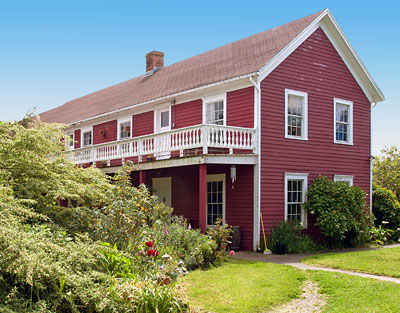National Register of Historic Places in San Mateo County
San Gregorio House
AKA Palmer Hotel
AKA Bell Hotel
Old Stage Road
San Gregorio
Built 1865
In 1865, each valley along the coast south of South Francisco contained a small village with a saloon, a general shore and occasionally a resort hotel. San Gregorio House and its dependencies are the only surviving coastal resort buildings.
George Washington Tull Carter, aged fifteen, came to California with his widowed mother in 1850. In 1865, he purchased five acres near the mouth of San Gregorio Creek and built a small hotel. The hotel became the nucleus of a village stretching along Stage Road.
Business was quiet during the rainy winters, but with passable roads in other seasons, the hotel would fill to capacity. For passengers riding the San Mateo-Pescadero stagecoach, it was a welcome interlude for rest and refreshment. For those on the Redwood City stagecoach, it was the end of the line. The hotel was a favorite with sportsmen. The French population of San Francisco particularly favored San Gregorio House.
In 1875, John R. Evans bought San Gregorio House and expanded it to its present size.
In 1888, Evans sold the land and hotel to Jesse Palmer and his business partner, Frank Bell.
In 1893, Frank Bell married Rebecca Tilden Palmer. After Frank Bell died in 1914, Rebecca Palmer Bell continued to operate the hotel until 1930, and she lived in the building until 1963.
When San Gregorio House was listed on the National Register of Historic Places in 1977, it was the home of Rebecca Bell's son.
In the early 20th century, the Ocean Shore Railroad ran as far south as Tunitas. Buses would carry passengers from Tunitas to San Gregorio. When automobile travel became common on the old stage roads, the summer recreational hotel business flourished.
The first adjunct to the hotel had been a saloon. With Prohibition, the saloon was converted to a gas station. Gasoline was transported to the station in fifty-gallon drums. The station attendant filled the tanks of the cars with a watering can while straining the gas through a chamois skin.
Automobile traffic in San Gregorio declined in the 1930s when the Coast Highway replaced Stage Road
as the main North-South highway.
Source: Adapted from the NRHP nomination submitted in 1977.

We were advised by a member of the Bell family that the property remained in her family until the 1990s.
